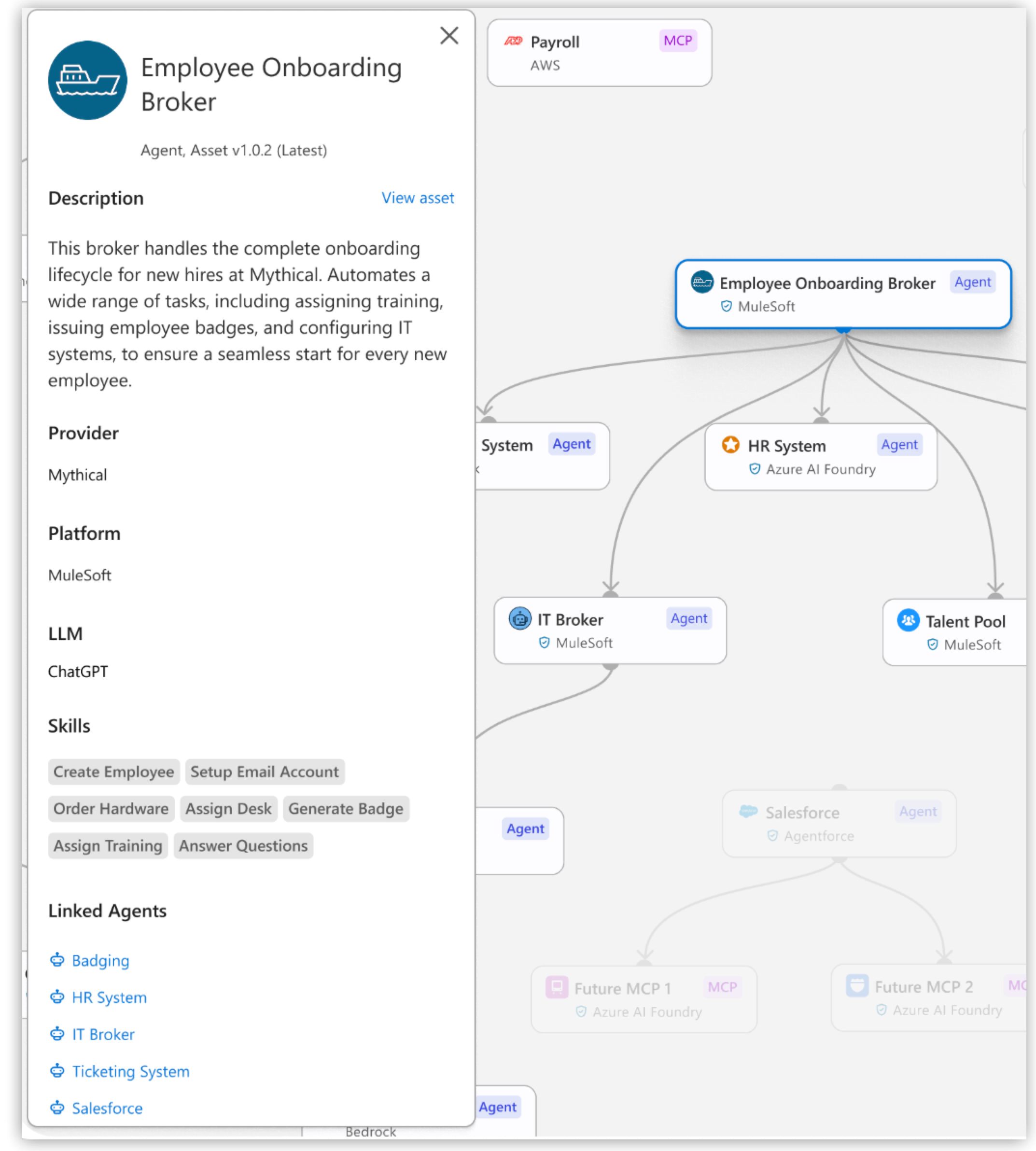
Agent Visualizer Components
Use Agent Visualizer to identify the parts of your agent network and see how they work together.
-
Distinguish node types (agents and MCP servers).
-
View edges to see declared and runtime interactions.
-
Use layers to focus views on specific environments
-
Open details cards to inspect metadata and metrics for nodes and access logs and traces
-
Review governance indicators such as Flex Gateway protection and applied policies.
Node Types
Nodes in the agent network provide a visual representation of the agents and MCP servers within your agent network including:
For more information, see Viewing Node Details.
Edges
Edges represent the relationships and communications among your nodes:
-
Declared edges appear between node instances when no runtime information is available because there’s no registered traffic between them. Dashed lines on the graph indicate declared edges.
-
Runtime edges appear between nodes when traffic is registered and a Flex Gateway exists. Solid lines on the graph indicate runtime edges. Clicking on a runtime edge opens the details card and shows the relevant metrics.
Edges are drawn under specific conditions, primarily when the calling agent is protected by a managed Flex Gateway at egress. For more information, see Deploying Agent Network Ingress and Egress Managed Flex Gateways.
-
If an agent has an egress managed Flex Gateway, when it calls another agent, the edge is visible.
-
If the requesting agent doesn’t have an egress Flex Gateway, no edge metric is generated and the edge isn’t shown.
-
Broker agents that route outbound calls through an egress Flex Gateway, allowing requests between broker agents, or from a broker agent to an external agent, appear in the agent network visualization.
Selecting an edge opens the details card, which displays relationship information and metrics. For more information, see View Edge Details.
Data Flow Layers
Agent Visualizer provides a single, consistent architectural view of all assets defined in Exchange. The base graph doesn’t change when toggling between production and non-production environments.
-
Base graph
-
Always visible
-
Shows all assets defined in Exchange (agents and MCP servers) and their design‑time relationships from broker definitions
-
Topology and layout do not change when switching layers
-
-
Production layer
-
Overlays production instances and metrics on existing nodes and edges
-
Hides sandbox traffic lines
-
-
Sandbox layer
-
Overlays sandbox instances (if they exist) and metrics on existing nodes and edges
-
Shows sandbox traffic as solid edges and hides production traffic lines
-
For more information about switching between production and sandbox environment layers, see View Data Flow Layers.
Details Cards
The details card is the primary means for gaining detailed, 360-degree information about a selected node or edge. It includes metadata and links to relevant resources like logs, policies, and more.

For more information, see View Node Details.
Node Metadata
When you select a node, the details card shows metadata for that asset, including:
| Field | Description |
|---|---|
Name |
Name of the asset. |
Description |
Description of the asset. |
Provider |
Provider of the asset. |
Platform |
Platform of the asset, for example, Agentforce or MuleSoft. |
LLM |
LLM provider (for example, |
Skills |
Skills that are supported by the agent. Skills are concrete, callable operations within a capability, with defined input and output. For example, |
Linked Agents |
Agents that are linked to the broker. |
MCP Servers and Tools |
MCP servers and tools that are connected to the broker. |
Enabled Capabilities |
Capabilities that are supported by the agent. Capabilities are high-level areas of what an agent can do (domains it supports, for example, customer support or knowledge search). |
Instance Name |
Instance name as it appears in API Manager. |
Environment Type |
Environments the instance is deployed to, for example, |
Based on Asset Version |
Version of the instance. |
Policies |
Policies that are applied to the instance. |
Governance and Security |
Whether the asset is protected by a Flex Gateway. |
Performance and Health |
Performance and health metrics for the instance including:
|
Monitoring |
Links to logs and traces for quick access to troubleshooting tools. |
Tags |
All tags associated with the asset in Exchange. |
| Broker metadata is defined in the agent network YAML. For more information about the agent network YAML, see Define Your Agent Network Specification. |
Instance Information for an Agent
When you select an agent node, the details card shows environment-specific instance details for that asset, including:
-
Latest asset version
The details card always shows the most recent (latest) asset version (highlighted) first, along with its corresponding instances in the selected environment (Production or Sandbox).
-
All earlier versions
All previous (earlier) instance versions are shown under the latest version.
Each instance entry includes the asset version number, so you can easily distinguish between versions.
-
Descending order of asset versions
Instances are ordered from the most recent (latest) to least recent (earliest) asset version, making it easy to track version history over time.



